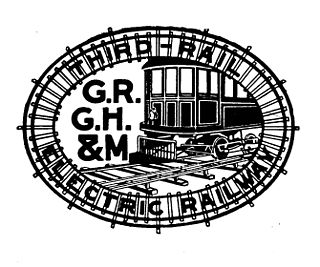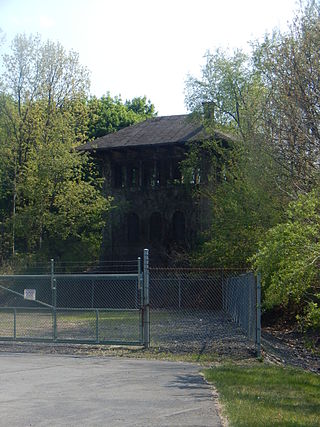
Moosic is a borough in Lackawanna County, Pennsylvania, United States, 3 miles (5 km) south of downtown Scranton and 10 miles (16 km) northeast of downtown Wilkes-Barre, on the Lackawanna River.

Scranton is a city in and the county seat of Lackawanna County, Pennsylvania, United States. With a population of 76,328 as of the 2020 U.S. census, Scranton is the most populous city in Northeastern Pennsylvania and the Wyoming Valley metropolitan area, which has a population of 562,037 as of 2020. It is the sixth-most populous city in Pennsylvania.

The interurban is a type of electric railway, with tram-like electric self-propelled railcars which run within and between cities or towns. The term "interurban" is usually used in North America, with other terms used outside it. They were very prevalent in many parts of the world before the Second World War and were used primarily for passenger travel between cities and their surrounding suburban and rural communities. Interurban as a term encompassed the companies, their infrastructure, their cars that ran on the rails, and their service. In the United States, the early 1900s interurban was a valuable economic institution, when most roads between towns, many town streets were unpaved, and transportation and haulage was by horse-drawn carriages and carts.

The Delaware, Lackawanna and Western Railroad, also known as the DL&W or Lackawanna Railroad, was a U.S. Class 1 railroad that connected Buffalo, New York, and Hoboken, New Jersey, and by ferry with New York City, a distance of 395 miles (636 km). The railroad was incorporated in Pennsylvania in 1853, and created primarily to provide a means of transport of anthracite coal from the Coal Region in Northeast Pennsylvania to large coal markets in New York City. The railroad gradually expanded both east and west, and eventually linked Buffalo with New York City.

The Wyoming Valley is a historic industrialized region of Northeastern Pennsylvania. The region is historically notable for its influence in helping fuel the American Industrial Revolution with its many anthracite coal-mines. As a metropolitan area, it is known as the Scranton–Wilkes-Barre metropolitan area, after its principal cities, Scranton and Wilkes-Barre. With a population of 567,559 as of the 2020 United States census, it is the fifth-largest metropolitan area in Pennsylvania, after the Delaware Valley, Greater Pittsburgh, the Lehigh Valley, and the Harrisburg–Carlisle metropolitan statistical areas.

The Delaware-Lackawanna Railroad is a shortline railroad operating in Northeastern Pennsylvania, especially the Scranton area.

Northeastern Pennsylvania is a region of the U.S. state of Pennsylvania that includes the Pocono Mountains, the Endless Mountains, and the industrial cities of Scranton, Wilkes-Barre, Pittston, Hazleton, Nanticoke, and Carbondale. A portion of this region is located in the New York City metropolitan area. Recently, Pennsylvania tourism boards have described Northeastern Pennsylvania as Upstate Pennsylvania.
Railroad electrification in the United States began at the turn of the 20th century and comprised many different systems in many different geographical areas, few of which were connected. Despite this situation, these systems shared a small number of common reasons for electrification.

The President Joseph R. Biden, Jr. Expressway, commonly referred to as the President Biden Expressway, and formerly known as the Central Scranton Expressway, is a 0.76-mile-long (1.22 km) freeway southeast of downtown Scranton in the U.S. state of Pennsylvania. It runs east-southeast from U.S. Route 11 /Pennsylvania Route 307 near downtown to Interstate 81 (I-81).

The Electric City Trolley Museum is a transport museum located in downtown Scranton, Pennsylvania, next to the Steamtown National Historic Site. The museum displays and operates restored trolleys and interurbans on former lines of the Lackawanna and Wyoming Valley Railroad, which are now owned by the government of Lackawanna County and operated by the Delaware-Lackawanna Railroad.

The Pennsylvania Northeast Regional Railroad Authority (PNRRA) is a bi-county creation of both Lackawanna and Monroe counties to oversee the use of common rail freight lines in Northeastern Pennsylvania. The designated freight operator of the Pennsylvania Northeast Regional Rail Authority lines is the Delaware-Lackawanna Railroad and tourism operator is Steamtown National Historic Site.
The Sunbury Line, formerly known as Sunbury Subdivision, is a rail line owned and operated by Norfolk Southern Railway which in turn is owned by the Norfolk Southern Corporation. The line travels from Sunbury, Pennsylvania, to Binghamton, New York, connecting with Norfolk Southern's Southern Tier Line at Binghamton and Norfolk Southern's Buffalo Line at Sunbury.

The Grand Rapids, Grand Haven and Muskegon Railway was an electric interurban railway that operated in west Michigan from 1902 until 1928.
Rocky Glen Park was a trolley park located near Moosic, Pennsylvania. Founded by Arthur Frothingham in 1886 as picnic grounds, it was transformed into an amusement park by engineer and entrepreneur Frederick Ingersoll in 1904. The park featured rides, arcades, and restaurants until its closure in 1987.

The Harrison Avenue Bridge was a concrete deck arch bridge carrying Harrison Avenue in Scranton, Pennsylvania, United States.

The Scranton Railway Company built and operated electric trolleys in and around Scranton, Pennsylvania, from 1896 until 1954.

Baldwin, the locomotive manufacturer, and Westinghouse, the promoter of AC electrification, joined forces in 1895 to develop AC railway electrification. Soon after the turn of the century, they marketed a single-phase high-voltage system to railroads. From 1904 to 1905 they supplied locomotives carrying a joint builder's plate to a number of American railroads, particularly for the New Haven line from New York to New Haven, and other New Haven lines. Westinghouse would produce the motors, controls, and other electrical gear, while Baldwin would produce the running gear, frame, body, and perform final assembly.
The Scranton, Montrose and Binghamton Railroad Company was an interurban railway, commonly referred to as the Northern Electric railway, which ran between downtown Scranton, Pennsylvania, and its suburbs to the northwest, including Clarks Summit, Dalton, Factoryville and Montrose.

Gravel Place is a location within Arlington Heights, Pennsylvania, about three miles (4.8 km) northeast of East Stroudsburg. It is neither incorporated nor a census-designated place, but has a name recognized by the USGS. From the 1880s to about 1950, it was a railroad yard of the Delaware, Lackawanna and Western Railroad (DL&W) on its mainline from Hoboken Terminal in New Jersey, which served New York City by ferry, to Scranton, Pennsylvania, continuing northwest into New York State with its western terminus in Buffalo, New York. It is just north of present Mill Creek Road.


















